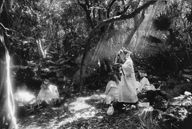Part 8
Earth Songs and Celestial Fantasies
A festoon of islands from Japan to Taiwan. Unique words, songs and fantasies, born and raised in the time and space of these islands. Rituals performed by women who communicate with the original deities. A snakeskin shamisen weaves melodies in a pan-Asian scale. Strange heavenly beings travel freely between heaven and earth, created by the power of the subtropical imagination. The luxurious growth of fantasy, brimming with song, the wandering deities. This is not a question of race or ethnicity. It is the power of culture cultivated in the place known as Okinawa.
| 1 | A Banquet of Sound and Fantasy |
 Tsukishiro Story
Tsukishiro Story
(“Tsukishiro monogatari”)- 1959 / Okinawan / Color / Video (orig. 16mm) / 40 min
Director: Ohinata Den
Production: Otohime Theater Troupe
Source: Okinawa Prefectural Archive
Literature on Japanese cinema has excluded mention of this film, made using the Okinawan dialect Uchina-guchi while Okinawa was still under U.S.occupation. Tsukishiro Story commemorates the tenth-year anniversary of the Otohime Theater Troupe, a women’s-only theatrical group disbanded in 2002, and was made as a companion-piece to Yanbaru Highway. Particularly notable is that the pair of films were directed by Ohinata Den, who had abandoned his career as a Shochiku star and moved to Brazil. This film is also remarkable for being in color.
 The Yoshiya Chiru Story
The Yoshiya Chiru Story
(“Yoshiya Chiru monogatari”)- 1962 / Okinawan / B&W / 16mm / 96 min
Director, Script, Producer: Kinjo Tetsuo
Photography: Yamazaki Masao
Sound: Ina Saburo
Music: Kuniyoshi Masako
Cast: Kiyomura Etsuko, Shima Seitaro, Senaha Takako, Hachiki Masao, Sagawa Masao
Source: Okinawa Prefectural Board of Education, Kinjo Kazuo
Ultraseven: The Young Messenger
(“Urutora sebun shirizu: nonmaruto no shisha”)-
1968 / Color / Video (orig. 16mm) / 25 min
Director: Mitsuda Kazuho
Script: Kinjo Testuo
Specialized Techniques, Special Effects Director: Takano Koichi
Alien, Monster: Nonmartan, Gailos
Source: Tsuburaya Productions
Broadcast Date: July 21, 1968
Okinawa experienced during childhood underpins the peerless creativity of Kinjo Tetsuo, the Ultraman scriptwriter. Though he went to study in Tokyo as a high school student, as a fresh university grad of twenty-four his desire was to make works showing the beauty of Okinawa. He returned to Okinawa with friend Nakano Minoru and tackled The Yoshiya Chiru Story, Okinawan theater’s most popular tale depicting the seventeenth century poetess Yoshiya Chiru, a prostitute who died at nineteen. Okinawa’s relationship with Japan can be layered onto The Young Messenger, a highly acclaimed episode within the Ultraseven series that shows Kinjo’s touch. “The earth is Nonmartans’ Star and humans are invaders” is a line that resonates with multiple meanings.
YIDFF Closing Screening
Song of Ajima
(“Ajimaa no uta”)-
2002 / Color / 35mm / 88 min / English subtitled version
Director: Aoyama Shinji
Photography: Tamra Masaki, Inomoto Masami
Editing: Oshige Yuji
Music: Teruya Rinken
Producer: Sento Takenori
Appearances: Uehara Tomoko, Teruya Rinken, Rinken Band
Production Companies: RENTRAK JAPAN, Ajima, Rumble Fish
Source: Pandora
Acclaimed around the world for his feature film Eureka (2000), Aoyama Shinji gives us a portrait of Uehara Tomoko, the lead vocalist of Rinken Band. The film highlights the story of Uehara’s participation in the band, as well as reflections on Uehara’s singing. As we see the performance and recording of Uehara’s stunning vocals, we get a picture of her everyday musical life. This film sings us songs, and charms us with Uehara’s performance, as if warming us in the Okinawan wind.
| 2 | Wandering of the Deities and Spirits |
Nanamui / Part 1 Ceremonial Songs
(“Nanamui / Kamiuta hen”)Nanamui / Part 2 Yuqui (annual ceremony giving thanks to the deities)
(“Nanamui / Yuqui hen”) For both films: 2003 / Color / Video / 79 min
For both films: 2003 / Color / Video / 79 min
Photography: Higa Toyomitsu
Editing: Tanaka Aiko
Production, Source: Ryukyu Islands Historical Society
Over forty ceremonies worshipping the locale’s most prominent guardian deities are held each year at Uharuzu Utaki in Nsumura, an area of Hirara City on Miyako Island. The interest of the photographer was piqued when he accidentally came upon one of these ceremonies. His rhythmic style captures a striking scene as priestesses, called nanamui, beckon him with their smiles, and draw him into the utaki. These priestesses are at once guardians, women and mothers, and extend a warmth and strength as they continue to sing.
